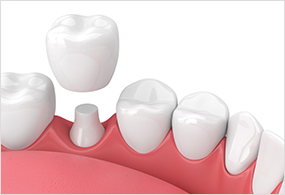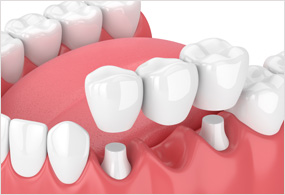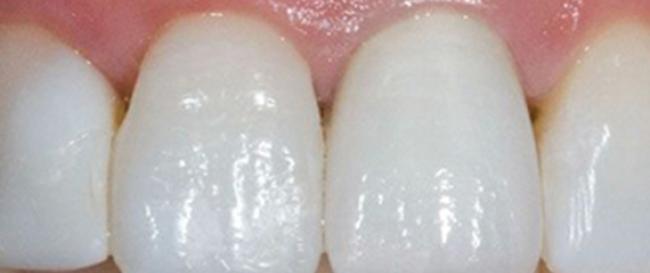Crowns and bridges are used to restore your smile and act like your natural, permanent teeth. Our competitive fees and convenient hours make it easy to stay on top of dental care. Schedule an appointment today.
- Locations
- Dental Services
Crowns and bridges are used to restore your smile and act like your natural, permanent teeth. Our competitive fees and convenient hours make it easy to stay on top of dental care. Schedule an appointment today.
A crown (or cap) is a protective restoration that covers the entire surface of a tooth and restores it to its original size and shape. When a tooth cannot be restored with a filling, a crown is used to protect and strengthen the tooth structure.
A crown is typically used to:
There are several types of crowns. All-ceramic crowns are the most widely used. Ceramic crowns are tooth-colored and are made to match the color, size, and shape of your teeth to give you a natural-looking smile. Crowns are very durable and will last many years, but may eventually need to be replaced like most dental restorations.

A crown can usually be completed in two appointments. A 3D digital scan will be taken at your first appointment and will be used to create your custom crown. During this first appointment, the dentist will also create a temporary crown for your tooth. You will wear the temporary crown for two to three weeks until your new crown is completed by a dental laboratory. The dentist will numb your tooth and prepare the tooth by removing any decay and shaping the surface to properly fit the crown. Your temporary crown will then be put in place with temporary cement and your bite will be checked to ensure you are biting properly.
At your follow-up appointment, your temporary crown will be removed, the tooth will be cleaned, and your new crown will be carefully cemented in place. The dentist will ensure your bite is accurate and the crown fits comfortably. You will leave with instructions on how to care for your new crown.

A dental bridge is a non-removable appliance used to replace missing teeth. While there are several types of bridges, the traditional bridge is usually made of ceramic fused to metal. These are very popular because they resemble your natural teeth. This all-ceramic bridge is made up of two crowns that go over two anchoring or abutment teeth, filling the gap created by one or more missing teeth. Dental bridges will last many years as they are highly durable. They may, however, need replacement or need to be re-cemented due to normal wear. Your dentist can help you with care instructions for your bridge.
A fixed bridge can be a great solution as it can prevent remaining teeth from drifting out of position, restore the ability to chew or speak and restore a beautiful smile. It can also be an upgrade to a removable partial denture.
Benefits of a dental bridge include:
Getting a bridge usually involves several visits. While the teeth are numb, the two anchoring teeth are prepared. A portion of the enamel will be removed to allow for a crown. Next, a highly accurate impression is made which will be sent to a dental laboratory so your bridge can be fabricated. A temporary bridge will be made, which can be worn for about three weeks until your next appointment.
At the second visit, the bridge foundation, known as the framework, will be carefully checked to ensure a proper fit. The dentist will select a shade of porcelain that is a good match with your adjacent teeth. The temporary bridge is cemented back in your mouth.
At the follow-up visit (usually 2 weeks later), the permanent bridge is ready to be inserted. The dentist will try it on, adjusting it as needed, polishing and inserting it with a permanent cement. To ensure the longevity of your permanent bridge, be sure to brush and floss every day and go for regular, routine dental visits.
An all porcelain crown replaces a porcelain to metal crown.

If your request is a dental emergency, or you would like to call and schedule your dental appointment, contact information for our offices can be found here: Great Lakes Family Dental Locations. New patient offer not valid for emergency appointments.